

Welcome to the agent-area of . Please select your name from the list below and you can access your personal information immediately!
Welcome to the agent-area.
Do you want to ...
Hello! You can create your own login below.
You successfully logged out. If you need access to the protected area again, you can login again at any time.
Greetings from Cuzco,
The Otto's Tours Team
Peru, Bolivia, Brazil
Peru, Bolivia, Brazil
This jungle tour with an expedition character takes you into the steaming Amazon basin, far away
from any mass tourism. You'll travel in small expedition boats, on truck beds and on cargo ships
through Amazonia.
 With a bit of luck, exotic wild animals will be observed live in one of the largest rainforest
areas on earth. The group goes on a 9-day boat trip deep into the Amazon jungle to visit indigenous
villages, illegal gold seekers and Brazil nut pickers. There will be extensive wildlife viewing,
jungle walks and expedition boat rides in or near these nature reserves: Amarakeiri, Tambopata,
Manupiri, Humayta & Manu, as well as to Lago Sandoval and to Monkey Island.
With a bit of luck, exotic wild animals will be observed live in one of the largest rainforest
areas on earth. The group goes on a 9-day boat trip deep into the Amazon jungle to visit indigenous
villages, illegal gold seekers and Brazil nut pickers. There will be extensive wildlife viewing,
jungle walks and expedition boat rides in or near these nature reserves: Amarakeiri, Tambopata,
Manupiri, Humayta & Manu, as well as to Lago Sandoval and to Monkey Island.
You will spend
the night in jungle settlements without any road connections. The tour also includes visiting banana
traders, jungle farmers, mini-schools and health stations. Small waterfalls and river beaches in the
middle of the jungle will offer enjoyable refreshment.
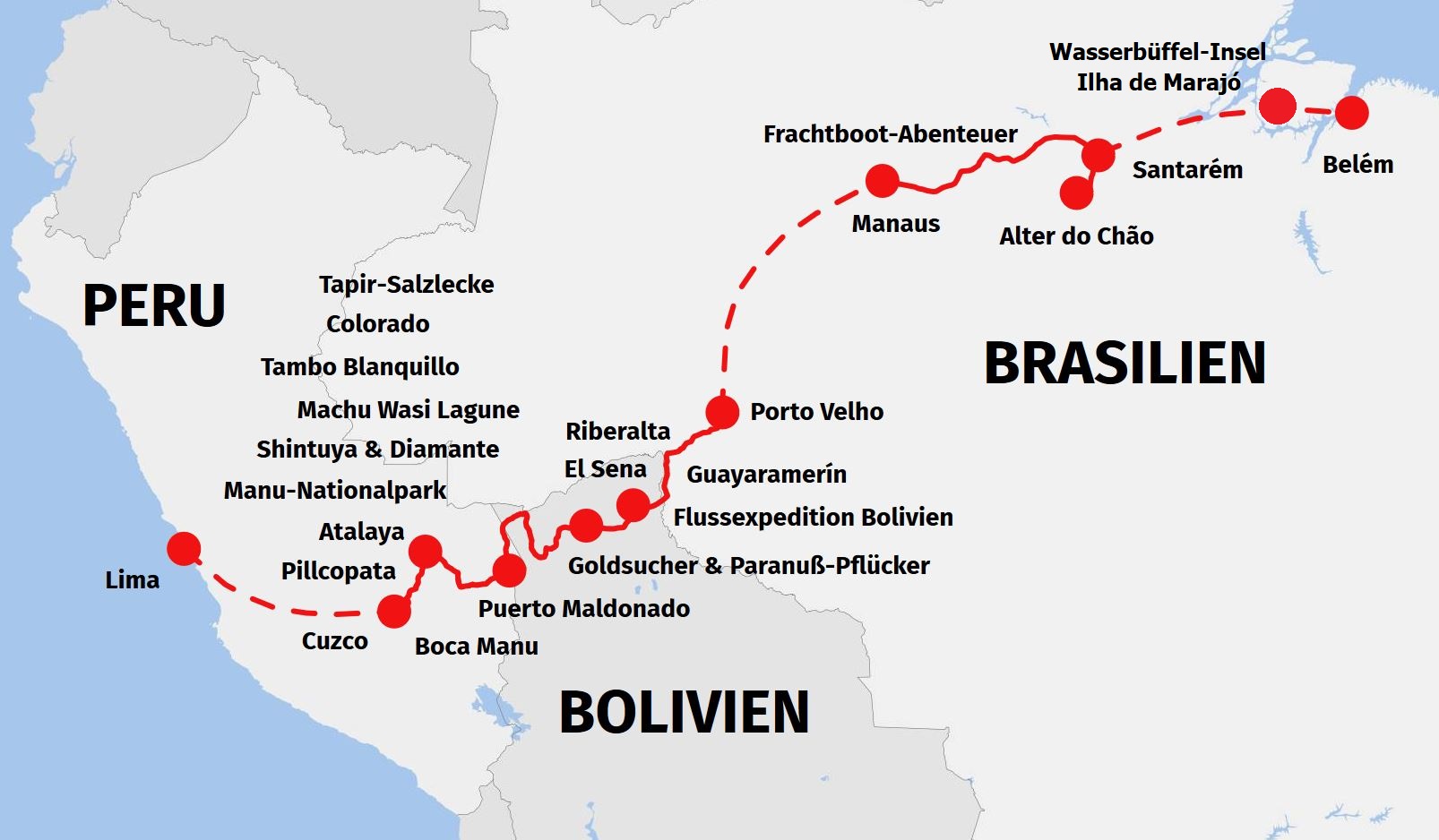 Culture is not neglected either, with visits to the famous opera and the colorful market of the
Amazon metropolis Manaus, as well as to typical salsa and samba dance bars. Near Manaus, a boat
tour will take you to the famous giant water lilies and the "meeting point of waters," where the
Rio Negro and the Rio Solimões meet to form the Amazon River.
Culture is not neglected either, with visits to the famous opera and the colorful market of the
Amazon metropolis Manaus, as well as to typical salsa and samba dance bars. Near Manaus, a boat
tour will take you to the famous giant water lilies and the "meeting point of waters," where the
Rio Negro and the Rio Solimões meet to form the Amazon River.
In the Amazon, the freedom of expeditionary travel still exists, where every new day is an adventure
and every human encounter arouses curiosity. It is a journey that adapts in many ways to the travel
group and the circumstances and so always results in something unique in itself!
This expedition is open to anyone in a normal physical condition, who is sure-footed enough for 2 to
3-hour hikes in a tropical climate and sometimes slippery jungle floor, and who can carry their own
luggage for a 150-meter distance.
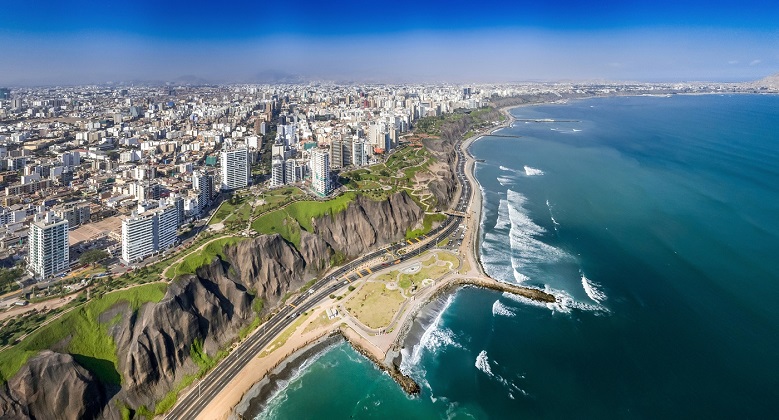 Arrival in the capital of Peru between 10:30 and 12:00 or 17:30 and 19:00, where we will be picked
up by our English-speaking guide and taken to our hotel near the airport (at other arrival times -
Spanish-speaking taxi driver). In the evening we will have our expedition briefing, where our guide
will go over the exact itinerary and will also be happy to answer any questions we may have. If the
group is not complete on the day of arrival, e.g. because of the previous tours, this meeting will
take place on the second day.
Arrival in the capital of Peru between 10:30 and 12:00 or 17:30 and 19:00, where we will be picked
up by our English-speaking guide and taken to our hotel near the airport (at other arrival times -
Spanish-speaking taxi driver). In the evening we will have our expedition briefing, where our guide
will go over the exact itinerary and will also be happy to answer any questions we may have. If the
group is not complete on the day of arrival, e.g. because of the previous tours, this meeting will
take place on the second day.
Our overnight in Lima at ***Hotel Limaq or equivalent. (No meals included)
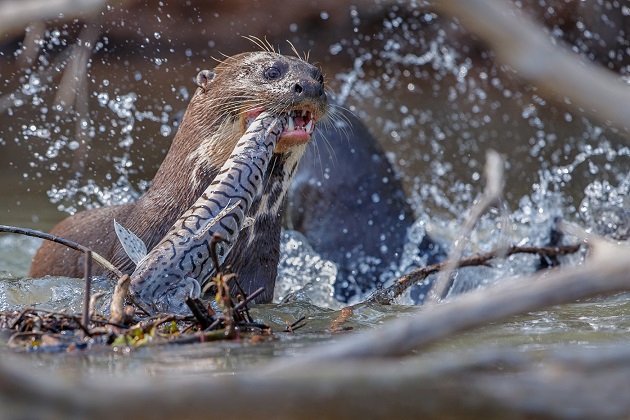 From Lima, we will fly very early in the morning to Cuzco, where we'll meet all the participants of
the previous tour and where everyone will be equipped with the absolutely necessary high rubber
boots. After this, we will take a minibus along a semi-paved road, across the mighty high Andes to
the ancient Aymara Burial Towers of Ninamarka, which we will visit on a short walk.
From Lima, we will fly very early in the morning to Cuzco, where we'll meet all the participants of
the previous tour and where everyone will be equipped with the absolutely necessary high rubber
boots. After this, we will take a minibus along a semi-paved road, across the mighty high Andes to
the ancient Aymara Burial Towers of Ninamarka, which we will visit on a short walk.
A little later, we will reach Paucartambo, where the famous masked carnival, which resembles a
whimsical theatre play, takes place in July. In Inca times, it was an important control post on
the southern border of the Inca empire, and still now, with its snow-white walls and azure doors
and balconies, Paucartambo reminds one of a noble ghost village. There, we will visit the local
museum and learn about the geography, history, culture, religion, rhythms and hopes of the
inhabitants of the small town.
Soon after, we will reach the former control post of the Manu National Park, where we'll have
lunch. From this point on we will travel downhill, further into the steaming Amazon, where we will
have the opportunity to observe the national bird of Peru, the "Gallito de Las Roca" (the Andean
Rockcock, also called the Andean Cliffbird).
Our overnight stay will be in Pillcopata, at the Gallito de Las Rocas Lodge of the Matsiguenka
Indians or in equivalent accommodation. (Full board)
 This day will start with a small tour of the village of Pillcopata. We'll visit the central square,
the small market and the local hospital to get a first insight into the life of the people in the
Amazon region.
This day will start with a small tour of the village of Pillcopata. We'll visit the central square,
the small market and the local hospital to get a first insight into the life of the people in the
Amazon region.
From Pillcopata, we will continue on winding roads through the jungle. We'll stop on the way at
an animal rescue station where wild animals, previously kept as pets, such as tapirs, monkeys,
caimans and sloths, are rehabilitated for a release back into the jungle.
On a guided tour of a small paradise-like orchid farm, we'll keep our eyes open for colorful
hummingbirds, which can be spotted drinking nectar. With a bit of luck, we will see up to 12
different species of hummingbirds! Afterwards, still in the morning, we will reach the small
harbor of Atalaya and board our expedition boat.
Following a short boat ride, we will reach our accommodation with a Matsiguenka family, situated
directly on the river and in the middle of the Amazon jungle. These indigenous people retain many
of their traditions as they were first Christianized by the Spanish Franciscans relatively late,
only at the beginning of the 20th century.
In the afternoon, we will set out on a first exploration hike with our nature guide. At a
romantically situated jungle lake we will board small wooden rafts and glide along the shore of
the lagoon to observe tropical birds, including the hoatzin, the "primitive bird", whose origin
is completely unknown, as well as crested chickens or gypsy chickens and, with a little luck,
giant otters.
After sunset, we will venture back into the jungle with our nature guide for a 2-hour night hike
to discover nocturnal animals.
Our overnight stay will be in a small lodge run by the Matsiguenka indigenous people. (Full board)
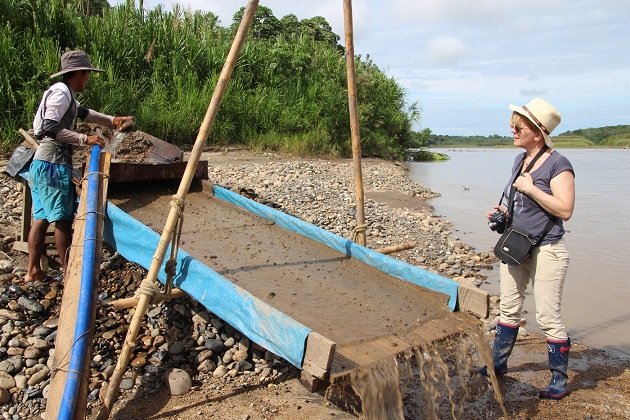 In the morning, we will leave for Shintuya, a village of the Matsiguenka indigenous people. We will
visit the local school here, where we'll have the opportunity to talk to the high school students
about their life in the jungle and their plans for the future.
In the morning, we will leave for Shintuya, a village of the Matsiguenka indigenous people. We will
visit the local school here, where we'll have the opportunity to talk to the high school students
about their life in the jungle and their plans for the future.
Afterwards, we will drive to a volcanic hot spring in the middle of the jungle and let ourselves be
pampered by its soothing, warm water.
In the afternoon, we will stop at a small jungle observation lodge, where we'll freshen up and then
be off on an exciting hike at dusk, through the overgrown and evergreen jungle. Saiba trees up to
55m high, chestnuts, countless palm species, lianas and strangler figs are just some of the trees we
will get to see there. The nocturnal animals will also be awake then and the trained eye of our
nature guide will spot them and point them out to us.
After reaching the 3m high tapir platform at the mineral lick, we will have dinner and lie down on
our comfortable mattresses. It'll be pitch dark and the sounds of the jungle will envelop us. At
any moment, the largest South American land mammal, the tapir, weighing up to 250kg, may come to
lick the minerals just a few meters away from us, as the tapirs urgently need the minerals contained
in the earth to aid their digestion.
Our overnight stay will be in Manu National Park in a simple jungle lodge. (Double room with bath/WC)
(Full board)
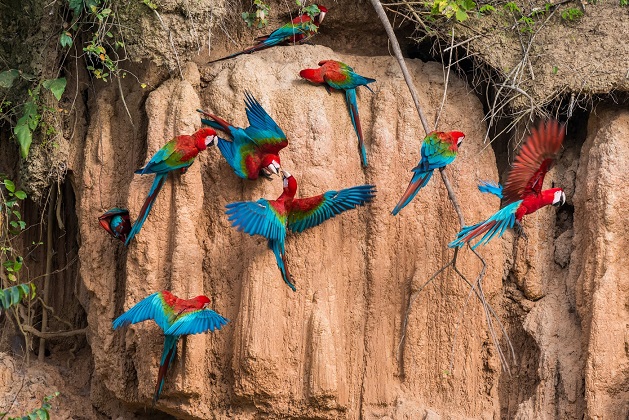 Before sunrise, we'll make our way through the deep jungle to our boat, where our boat team will
already be waiting with a delicious breakfast. On this day we will mostly be sitting, as we'll be
on the boat for a while. But this gives us another opportunity to look out for animals. Far away
from any civilization, and again with a little luck, we will be able to spot many exotic animals:
Macaws and parrots, capybaras, monkeys, caimans, sloths, butterflies, toucans and tropical birds
in the most colorful of colors, predatory cats, boas, anacondas and tarantulas.
Before sunrise, we'll make our way through the deep jungle to our boat, where our boat team will
already be waiting with a delicious breakfast. On this day we will mostly be sitting, as we'll be
on the boat for a while. But this gives us another opportunity to look out for animals. Far away
from any civilization, and again with a little luck, we will be able to spot many exotic animals:
Macaws and parrots, capybaras, monkeys, caimans, sloths, butterflies, toucans and tropical birds
in the most colorful of colors, predatory cats, boas, anacondas and tarantulas.
We'll stop at the indigenous village of Diamante, where we will be able to talk to the local
indigenous people with the help of the guide.
In the afternoon, we'll reach Boca Manu, once founded in the heyday of natural rubber by the
legendary Carlos Fitzgerald, also known as Fitzcarraldo. Today it is a supply village for the
indigenous people and gold seekers. Here we will visit the local shipbuilder, who had also built
our very own boat. He will explain to us exactly which materials he uses to build the boats,
which "models" he has and how his "distribution" is organized. In the evening we will enjoy a
cold beer in one of the small village pubs together with the locals.
Our overnight stay will be in very simple accommodations with a shared bathroom in the center of
Boca Manu. (Full board)
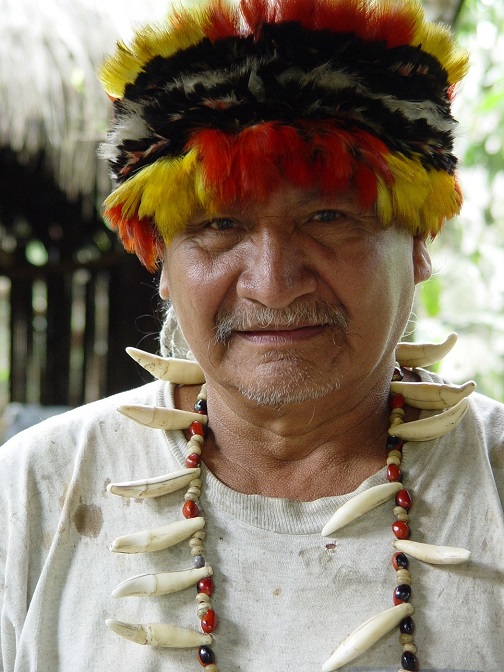 As the first golden rays of sunshine are reflected in the river, we will drive to an overlook,
where we have a great view of a parrot salt lick. Here we will have to be quiet and pull out our
binoculars to observe hundreds of huge macaw parrots!
As the first golden rays of sunshine are reflected in the river, we will drive to an overlook,
where we have a great view of a parrot salt lick. Here we will have to be quiet and pull out our
binoculars to observe hundreds of huge macaw parrots!
After this impressive natural spectacle, we will drive past illegal river gold mines to the
village of Colorado, which has retained the charm of a wild gold mining village to this day.
From here, we will have to change our mode of transport several times, as we will now travel
by jeeps and adventurous ferries, as well as halfway-inspection-compliant minibuses, on mostly
unpaved roads and later on the Trans-Oceanic Highway, completed in 2019, the connecting road
between the Atlantic and the Pacific, to the small, lively town of Puerto Maldonado, which is
crowded with motorbikes and tuk-tuks.
In the late afternoon we will visit the lively market there, with many fruits, vegetables, fish
species and local cuisine. A special refreshment is a cool Copoazu juice made from a jungle fruit.
If you want, you can then visit a local dance bar in the evening, where you will witness a
traditional cumbia live band, accompanied by many traditional dancers. Cumbia, a courtship
dance originally practiced among the African population, is the most popular music in the
Amazon region and is ubiquitous.
Our overnight stay will be in Puerto Maldonado at the ***Hotel Cabaña Quinta or equivalent.
(Breakfast & Lunch included)
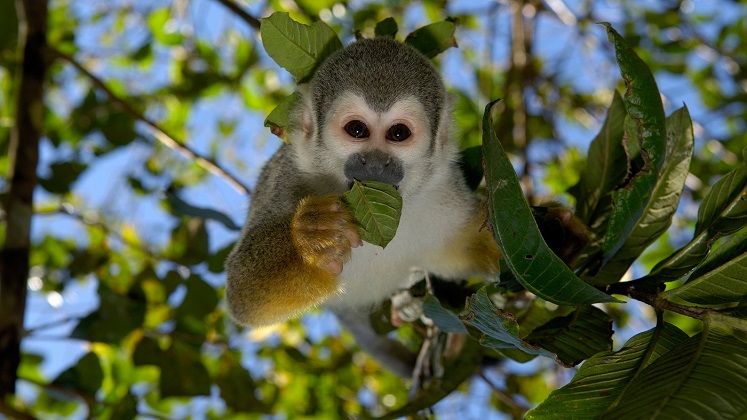 Early in the morning we will take our expedition boat on the Madre de Dios River to Monkey Island.
Deep in the jungle of the island, this is home to a variety of different monkey species, including
the maquisapas, the cheerful achunis, the impressive frailes and the small and funny leoncitos.
Immediately afterwards, we will walk for three kilometers through the jungle along the other side
of the river to a branch of the Madre de Dios river that has been cut off for hundreds of years
and is now a lake called Lago Sandoval. It is a paradise for the endangered giant otter and the
black caiman, as well as for many tropical birds. We will explore the river in canoes, accompanied
by our indigenous nature guide.
Early in the morning we will take our expedition boat on the Madre de Dios River to Monkey Island.
Deep in the jungle of the island, this is home to a variety of different monkey species, including
the maquisapas, the cheerful achunis, the impressive frailes and the small and funny leoncitos.
Immediately afterwards, we will walk for three kilometers through the jungle along the other side
of the river to a branch of the Madre de Dios river that has been cut off for hundreds of years
and is now a lake called Lago Sandoval. It is a paradise for the endangered giant otter and the
black caiman, as well as for many tropical birds. We will explore the river in canoes, accompanied
by our indigenous nature guide.
After lunch, we will continue through the Tambopata National Park to a remotely living shaman.
We will spend the night directly with the shaman in our camp beds equipped with mattresses and
cozy sleeping bags, as well as mosquito nets. An outhouse and an outdoor shower round off this
adventurous overnight stay. (Full board)
After a leisurely breakfast, we will hand over our luggage to our boat team, who we will meet
again in Bolivia in the evening. With our hand luggage, we will first drive along to the
Trans-Oceanic Highway to the Peruvian border station to pick up the necessary exit stamps.
We will then continue driving deep into the jungle in the direction of Bolivia, until the driver
of the minibus isn't able to go any further into the jungle, even if he wanted to. From here on
out, we will have to walk between 200m and 2,000m until we reach a small, completely remote
Bolivian police and military post. We will be inspected with some suspicion, as on average only
about 2 times a month someone crosses the border here.
Our passports will then be stamped at a further border checkpoint. Welcome to Bolivia! We will
then continue on only partially tarred roads until we reach a supply village located at the
river Rio Madre de Dios. Our boat team will already be waiting for us here with our luggage and
the already set-up camp beds.
After this eventful day, cool beers will be tempting us in one of the farmer and prospector pubs
there. Our cook will have already lit the barbecue and will be grilling delicious jungle
specialties here.
Our overnight stay will be on our camp beds or in very simple accommodation in the center of the
village. (Full board)
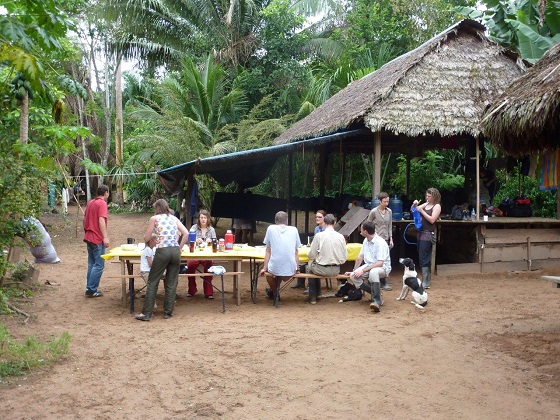 Early in the morning, our expedition boat will continue along the edge of the Manupiri and
Humayta nature reserves on the Madre de Dios River.
Early in the morning, our expedition boat will continue along the edge of the Manupiri and
Humayta nature reserves on the Madre de Dios River.
We will stop in one of the Brazil nut cultivation settlements directly on the river and let the
administrator explain to us how the Brazil nut is harvested. The Brazil nut tree, which is about
55-60m high and up to 300 years old, belongs to the monkey pot-fruit tree family and cannot be
cultivated. The 10-15cm large, hard shells contain 10-25 of the coveted and familiar tasty seed
kernels. They are picked up from the ground by 5,000 collectors in the rainy season and
transported up to 10km on narrow paths through the jungle by tractors to a collection center.
In the early afternoon, we will reach another Brazil nut settlement, where we will be able to
marvel at the enormous Brazil nut trees during a 2-hour hike. Afterwards, we will refresh
ourselves in a small river under a waterfall.
We will spend the night in our camp beds in the warehouse of this collective camp. (Full board)
 On this day, we will take the expedition boat along the Rio Madre de Dios River to some river
gold miners. We will board a gold diggers' boat and, on it, will learn exactly how they get the
gold out of the river and where and how they live there with their families. If the school of
this Brazil nut and gold digger settlement "America" is open, we will also visit it on this day.
On this day, we will take the expedition boat along the Rio Madre de Dios River to some river
gold miners. We will board a gold diggers' boat and, on it, will learn exactly how they get the
gold out of the river and where and how they live there with their families. If the school of
this Brazil nut and gold digger settlement "America" is open, we will also visit it on this day.
In the early afternoon, we will reach the small village of Sena and leave our beloved expedition
boat. On the back of an open pick-up or truck, we will drive for about 3 hours through the jungle
until we reach the colonial town of Riberalta.
Once there, we will take a short exploratory walk.
Our overnight stay in Riberalta will be at the Hotel Colonial** (a stylish former colonial house
of the local rubber baron) or equivalent. (Breakfast included)
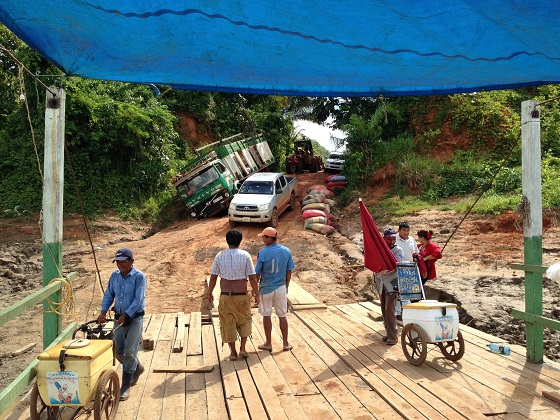 In the morning, we will visit a Brazil nut processing plant. Here, hundreds of tons of the precious
nut are cracked, washed and sorted by quality by several employees by hand. Next to the rubber of
the rubber trees and the wood from the tropical trees, the nutritious Brazil nuts are the most
important source of income for the local population.
In the morning, we will visit a Brazil nut processing plant. Here, hundreds of tons of the precious
nut are cracked, washed and sorted by quality by several employees by hand. Next to the rubber of
the rubber trees and the wood from the tropical trees, the nutritious Brazil nuts are the most
important source of income for the local population.
In the evening, we will go to the main square of Riberalta, where the whole village gathers and
roars around the "Plaza" on small mopeds and motorbikes for the evening entertainment.
Our overnight stay will be in Riberalta at the Hotel Colonial** (a stylish former colonial house
of the local rubber baron) or equivalent. (Breakfast included)
On this day, we will travel to the third country of our expedition: Brazil! Taxis will take us to
the Bolivian-Brazilian border river Rio Maroré and a ferry crossing will take us to the remote
Rondónia area, where mass clearing and fires were the order of the day until a few years ago.
Today, 80% of the burnt agricultural land stands fallow, waiting for more cattle. Fortunately,
this has already saved the Amazon region from further deforestation and slash-and-burn practices
for many years!
In the early evening, we will reach our small, very simple, city hotel. If you want, you can try
your first real Brazilian caipirinha and hit the dance floor.
Our overnight stay will be in Porto Velho at Hotel Regina** or equivalent. (Breakfast included)
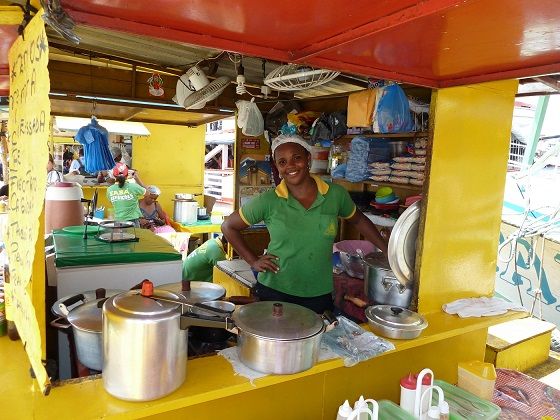 In the morning, we will get the opportunity to get to know Porto Velho a little better. We will
visit the old signal tower, with its ancient railways from the times of the rubber barons, as
well as the market and the harbor. It was only with the expansion of the railway, more than 130
years ago, that the settlement of the then completely untouched Amazon region began here in Porto
Velho.
In the morning, we will get the opportunity to get to know Porto Velho a little better. We will
visit the old signal tower, with its ancient railways from the times of the rubber barons, as
well as the market and the harbor. It was only with the expansion of the railway, more than 130
years ago, that the settlement of the then completely untouched Amazon region began here in Porto
Velho.
Around noon, we will reach the capital of the state of Amazonas, Manaus.
Here we'll visit the Teatro Amazonas, the Renaissance-style opera house in the middle of the former
jungle. It is not only a remnant of a time of immense prosperity, but its very symbol and now the
city's landmark.
On this night, we will stay for three nights in a beautiful hotel near the opera. What a luxury
after the past days in the deepest jungle!
Our overnight stay in Manaus will be at the Hotel Saint Paul or equivalent. (Breakfast included)
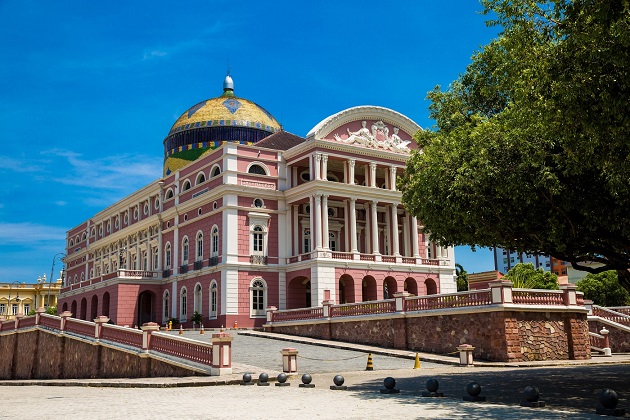 On this day, we will go on a discovery tour in Manaus, the multicultural "gateway to Amazonia",
bubbling with South American joie de vivre. Manaus: A mighty city, which can only be reached by
boat or plane.
On this day, we will go on a discovery tour in Manaus, the multicultural "gateway to Amazonia",
bubbling with South American joie de vivre. Manaus: A mighty city, which can only be reached by
boat or plane.
The city tour will first take us to the Mercado Municipal Adolpho Lisboa, a market hall built in
1883 on the banks of the Rio Negro, with fruits and spices. In the nearby fish market hall, we
will be amazed by the vast selection of huge Amazon fish.
In the evening, we will be able to enjoy a typical caipirinha in one of the small samba bars in
front of the beautifully lit Teatro Amazonas.
Our overnight stay will be in Manaus, again at the Hotel Saint Paul or equivalent. (Breakfast
included)
We will continue upstream along the mighty Rio Negro to the rubber museum "Seringal Vila Paraiso".
For us, this is a window to a bygone era: A time of unimaginable wealth but also full of brutal
violence and unspeakable suffering. It was the time when rubber was almost worth its weight in
gold and the rubber barons had magnificent palaces built in the jungle.
And the incredible wealth of Manaus at that time can still be seen to this day: The magnificent
opera house, for example, or the equally magnificent building of the "Palacio Rio Negro",
containing 26 rooms, which the German rubber baron Karl Waldemar Scholz had built for his wife.
He was one of the richest rubber barons of his day, and the stories about him are legendary.
Among the highlights of his excessive garden parties, were the tubs filled with champagne in
which young women bathed at late hours.
The rubber museum, which we will reach after only an hour's boat ride, is located on the grounds
of a former rubber estate and is the last remnant of the once booming rubber industry in the
Amazon. It was used as a film set for the movie "A Selva" (The Jungle). Here, some very realistic
scenery were recreated with original pieces.
In the film, a very dedicated woman tells the story of how the rubber tappers produced rubber
back in the days. The film itself was a flop: A long-winded, dramatically told story, but
lacking many details, hardly addressing the inhuman conditions under which the rubber tappers
had to work at that time.
The highlight of our visit will not only be the comparison of the house of the great rubber baron
with the living quarters of the destitute workers, but also a live demonstration of the extraction
of latex from a rubber tree. We will go into the original rubber tapper's hut, as well as into the
smokehouse, where we can learn all the steps involved in the rubber production process.
On the way back, we will make a three-hour stop at one of the most beautiful beaches near Manaus,
Tupé Beach. Here we can also enjoy the culinary delights of the small restaurants run by the
locals.
Our overnight stay in Manaus will be in Hotel Saint Paul or equivalent. (Breakfast included)
Unfortunately, it's time to say goodbye to South America and to a journey that each of us will remember for the rest of our lives. After breakfast, we will head to Manaus' airport, where our flight back home will await us. (Breakfast included)
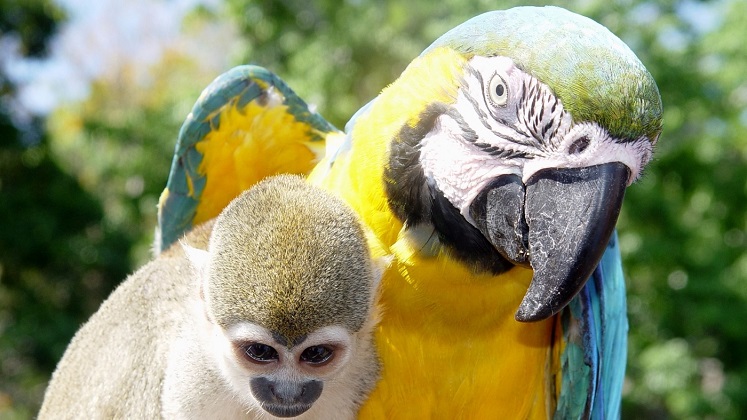
Entrance fees and national park fees approx. 130 USD per person (for whole 16 days). This will be collected by the tour guide in Lima in USD cash on the first day and settled on the last day. USD can be withdrawn with a MasterCard or VISA at the ATM in Lima. Tips, personal expenses, meals and drinks not included during hotel stays (approx. 350 USD).